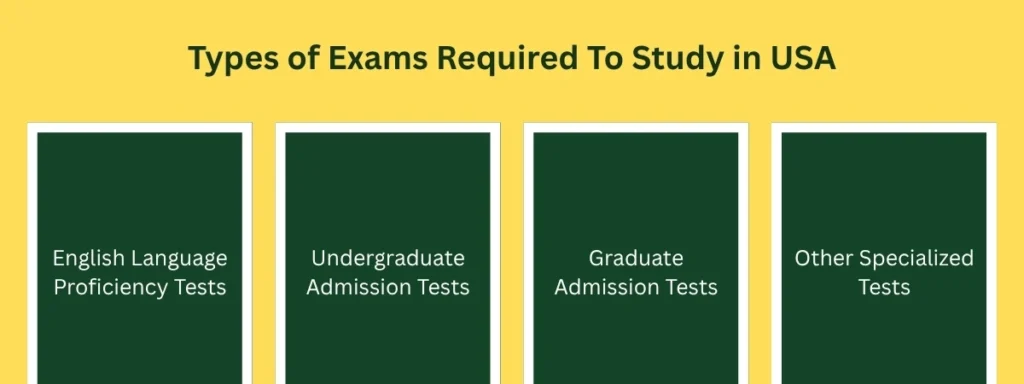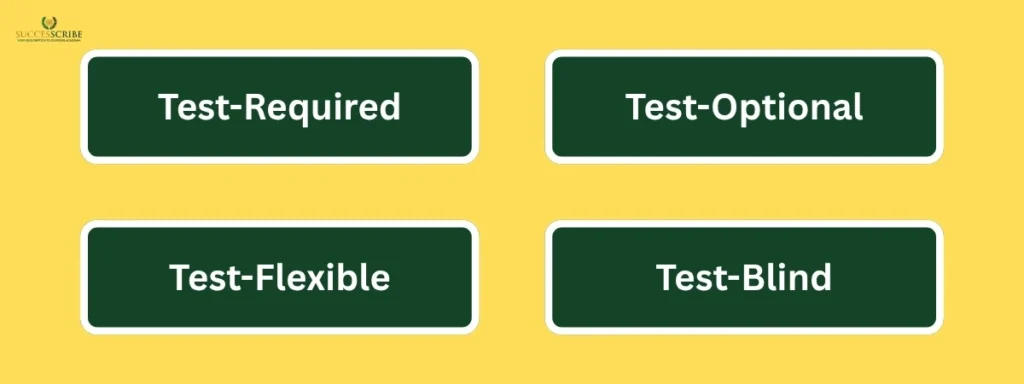The United States is a top destination for international students, offering world-class education and career opportunities. But before securing admission, students must clear standardized tests that evaluate language skills, academic readiness, and subject knowledge. Understanding the exams required to study in USA, like SAT, ACT, GRE, GMAT, TOEFL, and IELTS, is crucial for planning your academic journey. This topic provides a clear overview of these exams, their formats, fees, test centers, and their role in admissions and scholarships.
Why Are Exams Required to Study in the USA?

Exams help universities assess a student’s academic readiness, language proficiency, and aptitude for the program they intend to pursue. U.S. colleges and universities use these scores to compare applicants from different educational systems worldwide. The exams required to study in USA serve as a standardized way for universities to assess students’ academic preparation, language skills, and readiness for rigorous programs.
Main reasons exams are required:
- To assess language skills (English)
- To evaluate subject-specific knowledge
- To compare candidates objectively
- To meet visa requirements (in some cases)
Suggested Post: MBA in USA without work experience
Types of Exams Required To Study in USA

There are different categories of exams required to study in USA, including English language proficiency tests, undergraduate admission tests, and graduate-level entrance exams, each playing a distinct role in the admission process
1. English Language Proficiency Tests
International students from non-English speaking countries are generally required to take an English language proficiency test to prove that they can understand, communicate, and participate effectively in academic coursework conducted in English.
I. IELTS (International English Language Testing System)
Among the exams required to study in USA, IELTS is widely recognized and measures a student’s ability across four language skills – speaking, reading, writing, and listening. IELTS is another widely accepted English test that assesses your abilities in listening, reading, writing, and speaking. Many U.S. universities prefer IELTS, and it is considered more flexible for test takers in terms of test locations.
| Criteria | Details |
| Accepted By | More than 3,400 institutions in the USA |
| Format | Paper-based or computer-delivered |
| Sections | Listening, Reading, Writing, Speaking |
| Score Range | 1-9 bands |
| Minimum Score | Typically 6.5 to 7.5 bands |
II. TOEFL (Test of English as a Foreign Language)
The TOEFL is designed to measure the English language proficiency of non-native speakers. It evaluates the ability to use and understand English at the university level. Most U.S. colleges accept TOEFL scores, making it one of the most widely recognized English proficiency tests.
| Criteria | Details |
| Accepted By | Over 11,000 institutions globally |
| Format | Internet-based (iBT) and Paper-based (PBT) |
| Sections | Reading, Listening, Speaking, Writing |
| Score Range | 0-120 |
| Minimum Score | Varies by university (80-100) |
III. Duolingo English Test
Duolingo is a newer alternative to TOEFL and IELTS and gained popularity due to its affordability and convenience. It is conducted online and can be taken from home, making it ideal during travel restrictions or remote access challenges.
| Criteria | Details |
| Accepted By | Increasing number of U.S. universities |
| Format | Online, home-based |
| Sections | Integrated test format |
| Score Range | 10-160 |
| Minimum Score | 100-120 (depending on university) |
IV. PTE Academic (Pearson Test of English)
The PTE Academic test evaluates the real-life English skills of candidates who need to demonstrate their academic English language proficiency. It is accepted by many U.S. institutions and is known for delivering quick results.
| Criteria | Details |
| Accepted By | Over 1,000 U.S. institutions |
| Format | Computer-based |
| Sections | Speaking & Writing, Reading, Listening |
| Score Range | 10-90 |
| Minimum Score | 50-70, depending on the university |
2. Undergraduate Admission Tests
An undergraduate program in the USA refers to a post-secondary education program that leads to a bachelor’s degree. These programs typically take four years to complete and cover a wide range of fields like science, business, engineering, and humanities. If you’re aiming for a bachelor’s degree, the SAT and ACT are two major exams required to study in USA for undergraduate admission, helping institutions gauge your college readiness.
I. SAT (Scholastic Assessment Test)
The SAT is designed to assess a high school student’s readiness for college. It evaluates skills in reading, writing, and math. Many universities use SAT scores as a benchmark to compare applicants from different educational backgrounds.
| Criteria | Details |
| Administered By | College Board |
| Purpose | Measures literacy, numeracy, and writing skills |
| Sections | Evidence-Based Reading and Writing, Math, Optional Essay |
| Score Range | 400-1600 |
| When to Take | During high school (usually in 11th or 12th grade) |
II. ACT (American College Testing)
The ACT is another standardized test accepted by U.S. universities for undergraduate admissions. It includes a science reasoning section, which some students find advantageous over the SAT.
| Criteria | Details |
| Administered By | ACT, Inc |
| Purpose | Measures academic readiness for college |
| Sections | English, Math, Reading, Science, Optional Writing |
| Score Range | 1-36 |
| When to Take | High school students usually in junior/senior year |
3. Graduate Admission Tests
Graduate programs in the U.S., including Master’s (MS, MA) and Doctorate (Ph.D.) degrees, require students to demonstrate academic and analytical competence. This is typically done through exams such as the GRE, GMAT, and others depending on the field of study.
I. GRE (Graduate Record Examination)
The GRE is a standardized test that evaluates verbal reasoning, quantitative reasoning, and analytical writing skills. It is a common requirement for many graduate programs in the U.S. and is accepted in both STEM and humanities disciplines.
| Criteria | Details |
| Accepted By | Most graduate schools |
| Sections | Verbal Reasoning, Quantitative Reasoning, Analytical Writing |
| Score Range | 260-340 (Verbal + Quantitative), 0-6 (Writing) |
| Test Duration | About 3 hours and 45 minutes |
| Special GRE Subject Tests | For Physics, Chemistry, Mathematics, etc. |
II. GMAT (Graduate Management Admission Test)
The GMAT is used specifically for admission to business and management programs such as the MBA. It measures analytical writing, problem-solving, and logical reasoning skills.
| Criteria | Details |
| Accepted By | Business schools (for MBA) |
| Sections | Analytical Writing, Integrated Reasoning, Quantitative, Verbal |
| Score Range | 200-800 |
| Test Duration | About 3.5 hours |
III. LSAT (Law School Admission Test)
The LSAT is required for entry into law schools and tests skills that are critical for success in law school, such as reading comprehension, logical, and analytical reasoning.
| Criteria | Details |
| Accepted By | Law schools |
| Sections | Logical Reasoning, Analytical Reasoning, Reading Comprehension, Writing |
| Score Range | 120-180 |
| Duration | About 3.5 hours |
IV. MCAT (Medical College Admission Test)
The MCAT is used by medical schools to assess applicants’ knowledge of science concepts and critical thinking skills. It is one of the longest standardized exams.
| Criteria | Details |
| Accepted By | Medical schools |
| Sections | Biological Sciences, Physical Sciences, Psychology & Sociology, Critical Analysis |
| Score Range | 472-528 |
| Duration | About 7.5 hours |
4. Other Specialized Tests
In addition to general undergraduate and graduate admission exams, some academic disciplines in the U.S. require specialized tests for admission into professional programs such as dentistry, optometry, and pharmacy. These exams are typically taken by students applying for specific healthcare-related degrees. Beyond general exams, certain professional fields like dentistry and pharmacy have their own exams required to study in USA, such as DAT, OAT, and PCAT.
I. DAT (Dental Admission Test)
The DAT is required for students who want to pursue dental education in the United States. It is designed to assess general academic ability, comprehension of scientific information, and perceptual ability.
| Criteria | Details |
| Accepted By | Medical schools |
| Sections | Biological Sciences, Physical Sciences, Psychology & Sociology, Critical Analysis |
| Score Range | 472-528 |
| Duration | About 7.5 hours |
II. OAT (Optometry Admission Test)
The OAT is essential for admission to optometry schools and tests the scientific knowledge and skills necessary to succeed in optometry education.
| Criteria | Details |
| Accepted By | Admission to optometry schools |
| Sections | Survey of Natural Sciences, Reading Comprehension, Physics, Quantitative Reasoning |
III. PCAT (Pharmacy College Admission Test)
The PCAT is used to identify qualified applicants for pharmacy colleges. However, note that some pharmacy schools have moved to a test-optional policy or no longer require PCAT.
| Criteria | Details |
| Required For | Pharmacy schools |
| Sections | Writing, Biology, Chemistry, Quantitative Ability, Reading Comprehension |
Suggested Post: MBA in business analytics in USA
Exam Fee Summary Table
Understanding the exam fees is essential for budgeting your study abroad journey. Below is a comprehensive table showing the registration fees for the most common exams required to study in the USA. When preparing for the exams required to study in USA, understanding the cost structure helps students create an accurate budget for their academic plans. The fees are listed in both US Dollars (USD) and Indian Rupees (INR) for better clarity for Indian students.
| Exam Name | Fee (USD) | Fee (INR) |
| IELTS | $280–$340 | ₹15,500 |
| TOEFL iBT | $205 | ₹17,400 |
| Duolingo English Test | $70 | ₹5,845 |
| PTE Academic | $205 | ₹17,000 |
| SAT | $111 | ₹9,270 |
| ACT | $65–$90 | ₹5,428–₹7,515 |
| GRE General Test | $220 | ₹22,550 |
| GRE Subject Test | $150 | ₹14,500 |
| GMAT | $275 | ₹22,962 |
| LSAT | $222 | ₹18,516 |
| MCAT | $330 | ₹27,555 |
| DAT | $535 | ₹44,622 |
| OAT | $500 | ₹41,750 |
| PCAT | $210 | ₹17,535 |
Suggested Post: Masters in health informatics in USA
Do All Universities Require Exams?

Not all U.S. universities mandate standardized tests for admission. A growing number of institutions now follow test-optional or test-flexible policies. This change is largely due to the pandemic and growing emphasis on holistic evaluation.
Types of Admission Policies
| Policy Type | Description |
| Test-Required | Standardized tests are mandatory for admission |
| Test-Optional | Tests not required but considered if submitted |
| Test-Flexible | Students can choose from a list of exams or academic indicators |
| Test-Blind | Standardized test scores are not considered at all |
Top Test-Optional Universities
- University of Chicago
- New York University (test flexible)
- Bowdoin College
- Smith College
- Wake Forest University
These policies often apply to undergraduate programs, while most graduate programs still require standardized tests such as GRE or GMAT, although some are offering waivers.
Suggested Post: Masters in project management in USA
Impact of Exams on Scholarships
Standardized test scores not only help you gain admission to U.S. universities but also significantly influence your eligibility for scholarships and financial aid. For international students, particularly those from countries like India where affordability is a concern, high scores on entrance exams can be the key to unlocking generous merit-based scholarships and fellowships.
Why Do Test Scores Matter for Scholarships?
Many universities in the United States evaluate a student’s academic potential using standardized test scores. These scores are often one of the primary metrics for awarding merit-based financial aid, especially for international students who may not qualify for federal student aid.
High performance in exams like the SAT, ACT, GRE, GMAT, TOEFL, or IELTS reflects:
- Academic capability
- Strong language proficiency
- Preparedness for rigorous university programs
Universities want to invest in students who are likely to succeed academically, and test scores provide that evidence.
Types of Scholarships Influenced by Exam Scores
| Scholarship Type | Relevant Exams | Typical Award Value | Applicable Level |
| Merit-based Scholarships | SAT/ACT, GRE/GMAT | $5,000 – $30,000/year | UG/PG |
| English Language Proficiency Grants | IELTS/TOEFL/PTE | $2,000 – $15,000/year | UG/PG |
| Departmental/Subject-Based Awards | GRE Subject Test | $5,000 – $25,000/year | PG/PhD |
| Presidential/Chancellor Awards | SAT/ACT, TOEFL/IELTS | Full tuition or partial aid | UG |
| Research/Teaching Fellowships | GRE/GMAT, IELTS/TOEFL | Stipend + tuition waiver | PG/PhD |
Some universities continue to award scholarships only to students who submit test scores, even if the school follows a test-optional admission policy.
Examples of Universities Offering Exam-Based Scholarships
| University | Exam-Based Scholarship | Minimum Score Criteria |
| University of Alabama | Academic Elite Scholarship | ACT 32+ or SAT 1450+ |
| University of Southern California | Trustee/Presidential Scholarships | SAT 1500+ or ACT 33+ |
| NYU | AnBryce Scholarship | SAT/ACT + Academic profile |
| University of Texas at Austin | Global Excellence Scholarship | High TOEFL (100+) and SAT/GRE |
| Ohio State University | International Merit Scholarships | SAT 1380+ or TOEFL 100+ |
Suggested Post: Masters in human resource management in USA
When and Where to Take These Exams
Understanding when and where to take your entrance exams is crucial for planning your study abroad journey. The timing directly affects your application deadlines, scholarship opportunities, and even visa processing. With many exams offered multiple times a year and available in various formats (in-person and online), you have flexibility, but it’s essential to plan strategically. Planning when and where to take the exams required to study in USA ensures that you meet application deadlines and secure your spot at top universities
Ideal Time to Take the Exams
To align your test dates with U.S. university admission cycles (primarily Fall and Spring intakes), you should take your exams at least 6–12 months before your intended intake.
| Intake Season | University Application Deadline | Ideal Exam Window | Latest Safe Attempt |
| Fall (Aug–Sep) | December to March (of same year) | June – December (previous year) | January – February (same year) |
| Spring (Jan) | August to October (previous year) | March – July (previous year) | August – September (same year) |
Conclusion
Knowing the exams required to study in USA is a key step toward your dream of studying abroad. These tests help universities assess your readiness and also open doors to scholarships and assistantships.
With early preparation and the right strategy, strong exam scores can boost your chances of admission and financial aid. Use this information to plan wisely and take confident steps toward your U.S. education goals.
FAQs
Can I study in the USA without taking any standardized exams?
Yes, many universities in the USA have adopted test-optional or test-flexible policies, especially for undergraduate programs. However, competitive scholarships and graduate programs may still require exams like GRE, GMAT, or language proficiency tests.
Which English proficiency test is most widely accepted in the USA?
The TOEFL iBT is the most widely accepted English test across U.S. institutions, followed closely by IELTS. However, Duolingo English Test and PTE Academic are also gaining rapid acceptance due to their flexibility and affordability.
What is the minimum GRE score required for MS in the USA?
There’s no universal cutoff, but most top universities prefer a GRE score between 310–330. Competitive programs in STEM may expect higher scores, particularly in the Quantitative section.
Are scholarships available for Indian students based on entrance exam scores?
Yes, many U.S. universities offer merit-based scholarships that depend on your performance in exams like SAT, ACT, GRE, GMAT, TOEFL, and IELTS. High scores can lead to awards ranging from $5,000 to full tuition.
Which is easier – IELTS, TOEFL, or Duolingo?
The Duolingo English Test is considered more user-friendly and can be taken from home, but its acceptance is limited compared to TOEFL and IELTS. TOEFL is more academic-focused, while IELTS is slightly more flexible with its paper-based and computer-based options.
Related Post
Duolingo accepting universities in USA
Animation courses and universities in USA
Aerospace engineering in USA
Bachelor in Computer Science in USA















